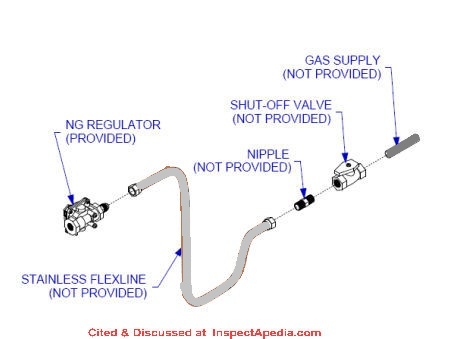 Flexible Connector Tubing Types For Outdoor Gas Grill
Flexible Connector Tubing Types For Outdoor Gas Grill
Choose the proper (safe) flexible gas line LP vs Natural Gas
- POST a QUESTION or COMMENT about flexible connector tubing or pipes for hooking up an LP, propane, or natural gas supply to an outdoor grill, BBQ, or some other appliances.
This article discusses connector requirements & types of tubing or hoses used to connect outdoor BBQ grills, cookers, or similar appliances to LP or natural gas supplies.
Page top photo: stainless steel tubing and other fittings used to connect a Bull Lonestar gas grill to a piped-in natural gas supply - cited & described in more detail on this page.
InspectAPedia tolerates no conflicts of interest. We have no relationship with advertisers, products, or services discussed at this website.
- Daniel Friedman, Publisher/Editor/Author - See WHO ARE WE?
Flexible tubing Choices When Connecting an Outdoor Gas Appliance to LP or Natural Gas
Different types of tubing, connections, and shutoff valves will be required depending on whether you are connecting your gas grill to an LP tank (with its own shutoff valve) or to a building's natural gas supply line.
Typically the manufacturer provides a Type 1 ANSI or CSA Approved rubber gas hose for connection to an external LP gas tank and may supply a listed stainless "flexline" gas tube to complete the gas routing inside the grill and to its burner controls. The shutoff valve on the LP gas supply tank is the main gas shutoff.
Shown above: an LP gas tank, Type 1 tank shutoff valve, connection to an LP gas pressure regulator and flexible LP gas hose used to connect an XO gas grill, cited in detail at the end of this article.
Choose the Proper Flexible Tubing to Match the Gas Type - LP or Natural Gas
Choose the proper flexible gas tubing or hose type when connecting a gas grill to your LP or propane fuel supply.
For natural gas connections a flexible stainless steel gas line along with appropriate pipe fittings and a gas shutoff valve mounted on the gas piping will be required and are usually not included by the manufacturer of the gas grill.
First, be sure you follow the specific connection instructions given by the manufacturer of your gas grill, because their specifications vary.
For example, a manufacturer may permit use of or even supply a flexible hose for connecting the grill to an LP gas tank, but you might be required to purchase separately a stainless steel flexible gas line, pipe nipple, and shutoff valve when connecting to a building's existing gas supply piping.
Also you may need to change gas metering orifices or controls on your grill when changing the fuel type. Below are some additional gas supply connector kit examples that might - or might not - be acceptable by your particular grill's manufacturer.
Combination Propane OR Natural Gas Connector for Outdoor Gas Grill
Watch out: Some gas connector lines, but not all of them, are rated for both LPG and natural gas fuels.
Do not use propane gas connectors nor other parts on a natural gas barbecue BEFORE reading the specifications for your specific product.
Below is a propane-/-natural-gas connector kit - this example is the Permasteel Natural Gas Conversion Kit for Kenmore Grills 6-Burner + Side Burner.
As you can see, those are different materials.
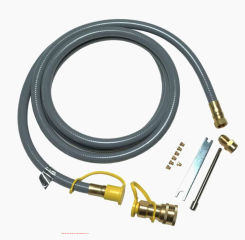
Propane Only Gas Grill Connector Tubing
Just below we show a connector hose described as rated for propane gas.
Change Hoses When Converting fro Propane to Natural Gas?
Take a look at the materials and also take a look at the requirements to convert a gas grille from Propane to Natural Gas - my second illustration below.

Bottom line:
You MIGHT be able to use the same hose for connecting to EITHER Propane or Natural Gas **if** the hose is specifically rated for both fuels.
An example is shown below, from M.B. Sturgis Co., a hose that is specifically rated as OK for either fuel (shown as sold at Amazon) described as
3/8" ID Thermo Rubber High Pressure Propane/Natural Gas Hose with 3/8" 45 Degree Female Flare Swivels on each end.
Versatile hose can be used for any Propane or Natural Gas Appliance connection. The Female Flare Swivels make connecting to the supply or appliance easy.
Thermo Rubber Hose stays very flexible in cold weather.
350 PSI Max Pressure Rating
Certified to UL21, UL569, CAN 8.3
shown above
Converting Gas Grill or Other Appliances From Propane to Natural Gas or Vice Versa
Most gas appliances are sold set up for just one of the two fuel options: either natural gas or propane. If you are changing fuels or if your new grill or heater, generator or other gas appliance was delivered set up for the wrong fuel for your home, you'll need to convert it for use with your fuel.
Usually this involves changing at least the gas metering orifices in the appliance, and it might also require changing the flexible gas line between fuel source and appliance.
Weak Gas Flame Caused by Wrong Gas Metering Orifices?
If the gas flame is weak in your appliance that might suggest problem with the gas supply system such as wrong gas orifices OR it could be due to an improper gas regulator set-up OR to a blockage in the gas piping or tubing.
Your engineer may want to check that the gas delivery is adequate, including total piping lengths, diameter, elbows, and regulators. It's possible that there's a gas line blockage or that the primary or appliance regulators are not properly adjusted.
Do Not Connect a Propane Grill or Heater to a Building's Natural Gas Supply
Unless you're planning on installing a commercial-kitchen type gas grill you'd use the same pressure as other home appliances - which is what I'm guessing you mean by "low pressure burners" - as per the
article GAS PRESSURES LP vs NATURAL GAS.
Most portable outdoor gas BBQ or Grill equipment is sold set up for use with propane - that operates at a higher pressure than residential natural gas supply.
So your outdoor gas grill has to be a model whose controls, regulator, and gas jets are sized for natural gas pressures rather than LP gas pressures.
Different Flexible Gas Line Inside vs Outside a Gas Grill
Some outdoor gas grills require two different gas tubing connectors: outside the grill a flexible rubber line may be permitted, but inside the body of the grill, where temperatures may be higher, a more fire and heat resistant tubing may be required, such as a flexible stainless steel tubing connector.
Watch out: For example, connecting a BBQ grill that moves about or that uses a portable propane tank will NOT use a corrugated metal connector tube (CSST) shown just above. CSST, while flexible, is not intended for use where regular movement of the appliance is going to occur. Instead it will use a reinforced poly or rubber tube.
See details at GAS PIPING, FLEXIBLE CSST
...
Reader Comments, Questions & Answers About The Article Above
Below you will find questions and answers previously posted on this page at its page bottom reader comment box.
Reader Q&A - also see RECOMMENDED ARTICLES & FAQs
Which color handle/connector do I connect my gas grille to on the LP gas bottle?
I bought a gas bottle with a red and black inlet. Which colour do I connect to? - On 2017-04-27 by Santie
On 2017-04-28 by (mod) - MB Sturgis / Camco Propane Gas Connector Knob Colors indicate BTUH operating ranges or gas delivery capacities
Sorry Santie, I don't know what you're connecting, what gas (LPG?), what appliance or device, nor why there would be two connectors on an LP cylinder.
For example in North America a gas grille or BBQ uses a 3/8" flared female fitting on the appliance hose end and a standard propane tank fitting (reverse thread) on the bottle end.Where your propane cylinder provides different colored connectors here is what they mean when found on gas supply cylinders or bottles at a camper or trailer:
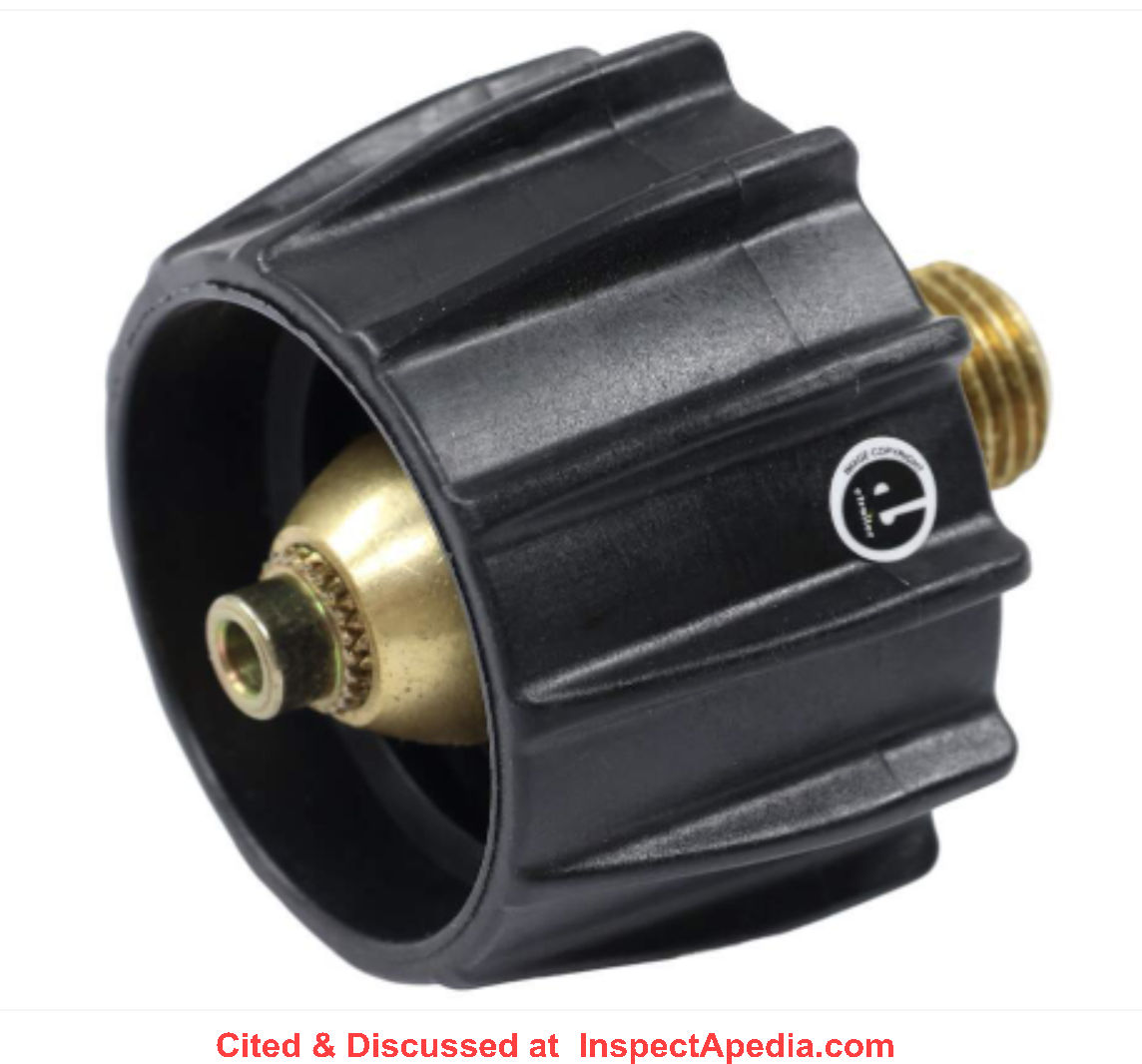
- Black gas connector: rated for 70,000-100,000 BTUH
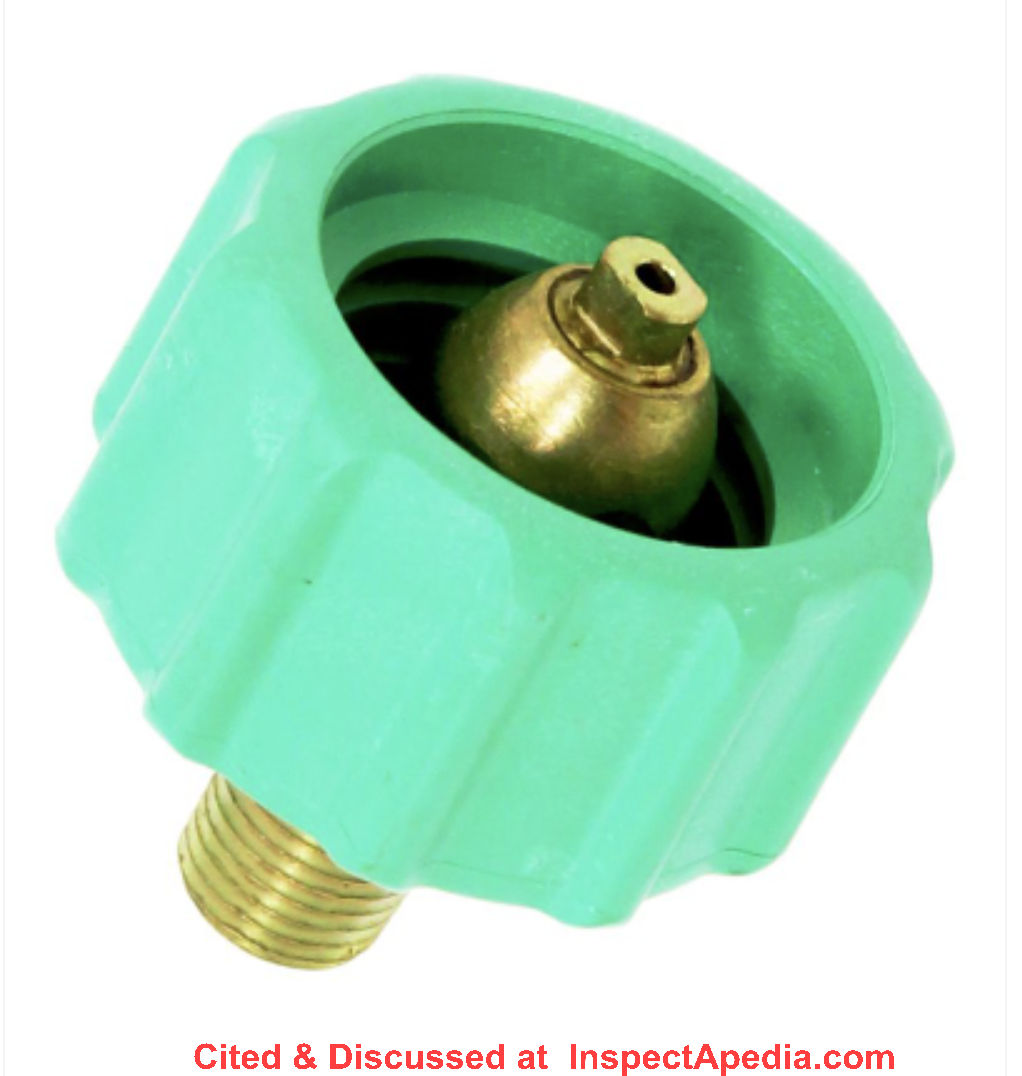
- Light Green gas connector: rated for 200,000-400,000 BTUH

- Dark Green gas connector: rated for 450,000-500,000 BTUH
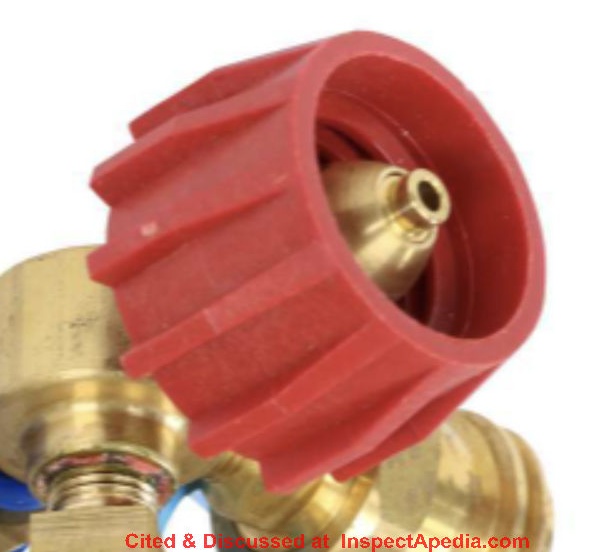
Source for the above gas bottle connector type images: etrailer.com supplier of trailer & RV parts & products. 2024-06-07
- Red gas connector: used for high pressure adapters and fittings that will supply gas over a longer piping distance to an appliance that will also use its own gas pressure regulator to step down the pressure to that required by the specific appliances. Rated for up to 250 psi.
Gas meter distance to grill
We have a gas grill that hooks on to gas line on deck. Is there a safety distance that the grill to hook up to gas line on deck. Can it be 13 ft away? - On 2017-03-25 1 by Dsaady
Reply by (mod)
If you mean can you put the grill 13 ft. away from the gas hookup = you'll doubtless want to extend the metal gas piping for safety;
I'd not enjoy living with a 13 foot flexible gas line and I doubt you'd find one.
A gas grill explosion occurred same day the underground LP tank was filled.
A gas grill explosion occurred the same day the underground tank was filled. Could there be a connection! - On 2015-10-27 by Sandra -
On 2015-10-27 by (mod)
Good question Sandra.
Occam's razor says the simplest explanation is usually the correct one.
Put another way, coincidences deserve to be treated as suspect. Coincidences are possible, but suspect.
I cannot think of any immediate, obvious way that re-filling a propane tank would cause an explosion at one of the home appliances, but then I haven't inspected your home.
If, for example, in the course of getting to the LP tank someone disturbed the gas grill or its piping that could be significant;
LP tanks are typically filled to about 90 % of capacity, in order to be sure that there is gas not liquid LP at the top of the tank. That measure is taken to be sure that we don't send liquid fuel into the gas regulator - an event that could cause trouble.If your LP tank was over-filled and the regulator damaged, that might cause improper primary gas pressure regulation and that might show up at one of the gas appliances.
My advice: turn off the LP gas fuel supply at the tank immediately.
Then ask for help from a professional: check the gas system pressures to be sure that the regulator at the tank and at the gas appliances are working properly.
Question: hooking up an LP gas grill - proper regulator, pressure, piping?
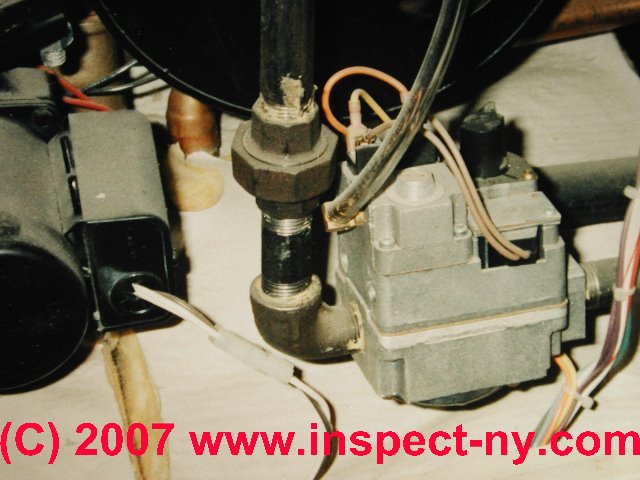 I have a new "built-in" outside grill that I am hooking up to a 15 lb. portable propane tank (located in a separate compartment). The manufacturer said that I need to get a high pressure regulator.
I have a new "built-in" outside grill that I am hooking up to a 15 lb. portable propane tank (located in a separate compartment). The manufacturer said that I need to get a high pressure regulator.
The grill needs an 11" water column. What PSI would I need for that? I have found some High Pressure Stainless Braided Propane Hoses with a 30 PSI Adjustable Regulator.
Should I get the 0-30 adjustable or do I only need one with a set PSI (10 PSI for instance)? Please respond ASAP.....THANKS! - 8/20/14 Nicky
Reply:
Nicky,
I'm confused and surprised by the report of manufacturer's advice and suggest you go back to them to be sure we're all talking about the same product.
Usually we use a higher pressure LP gas regulator at a tank when the fuel delivery line is long and/or has to feed multiple appliances. Then each appliance has its own final gas pressure regulator to properly dispense gas at the right pressure to the burners.
For an LP gas grill whose portable propane tank is located right next to the grill itself, you'd think that the grill would have come with a single, adequate regulator to operate the appliance. \
What do the installation instructions for your grille say?
Reader follow-up:
Nicky said:
I Napoleon grill Model BIM605 which can be hooked up to propane or natural gas. The propane instructions says:
"Do not use hose to connect the unit. It must be connected with either rigid pipe, copper tube or an approved flexible metal connector [of sufficient length]
The gas supply must be connected to the 3/8" flare fitting located under the right hand side of the control panel."
It mentions using a separate line that branches off (only if using a side burner, which I'm not) It mentions the propane cylinder must be in a separate ventilated enclosure (which I have done).
While trying to find the braided hose online I saw both Low & High pressure hoses,
so I called Napoleon with my model #. I was told that I would need the High pressure hose, and that the grill required 11" water column. When I asked what PSI that would be, they told me to have the Gas Company or a licensed gas fitter install it & use a manometer.
This is crazy! We don't have gas on our street, and I hate to pay to have someone come just to connect 2 ends of a hose. THANKS Dan!
Reply:
Thanks for the added detail Nicky.
11 inches WC is about 0.4 psi - very low. Using high pressure hose is always safe - it's simply more durable.
That's a standard LP appliance pressure and you'll see it appearing in our
article GAS PRESSURES LP vs NATURAL GAS.
Nothing odd there. But you should understand that the grill company gets scared (we all do) when hearing questions from someone they don't know - they figure if you blow yourself up they don't want to be blamed.
What's critical, besides using safe plumbing as recommended by the manufacturer is having the right pressure delivered to the burners. If the grill does not contain its own pressure regulator that's why you'd need that equipment.
You can see the typical pressures at which LP gas is delivered (as a gas) to appliances as a function of temperature, in the table in the article I just cited.
On the portable grills I've seen the LP tank connects to a single stage regulator that is in the appliance and that regulates gas flow to the proper pressure.
At the end of the day, either you or your installer need to follow clear instructions from the manufacturer to be sure the installation is safe.
Watch out: gas grill we suggest keeping the gas turned off at the rubber hose connection for outdoor gas grill or BBQ installations, as leaks could be very dangerous.
The use of rubber tubing rather than iron piping is unsafe and may not be permitted for these installations, so if you find a simple rubber tube connecting your gas grill, we suggest you review this question with your local fire inspector. Usually this is not a significant expense if correction is needed. For safety, do this promptly.
...
Continue reading at FLEXIBLE GAS CONNECTOR INSTALL, or select a topic from the closely-related articles below, or see the complete ARTICLE INDEX.
Or see these
Recommended Articles
- GAS APPLIANCE CONVERT LP-to-NATURAL GAS
- GAS LEAK DETECTION, LP / NG
- GAS PIPING, VALVES, CONTROLS - home
- GAS PRESSURES LP vs NATURAL GAS
- GAS COOKTOP INSTALLATION
- GAS REGULATORS & APPLIANCE / HEATER CONTROLS
- GAS REGULATORS for LP TANKS
- GAS SUPPLY for ELECTRIC GENERATORS
Suggested citation for this web page
GAS CONNECTOR for BBQ GRILL at InspectApedia.com - online encyclopedia of building & environmental inspection, testing, diagnosis, repair, & problem prevention advice.
Or see this
INDEX to RELATED ARTICLES: ARTICLE INDEX to GAS APPLIANCES, PIPING, CONTROLS
Or use the SEARCH BOX found below to Ask a Question or Search InspectApedia
Ask a Question or Search InspectApedia
Try the search box just below, or if you prefer, post a question or comment in the Comments box below and we will respond promptly.
Search the InspectApedia website
Note: appearance of your Comment below may be delayed: if your comment contains an image, photograph, web link, or text that looks to the software as if it might be a web link, your posting will appear after it has been approved by a moderator. Apologies for the delay.
Only one image can be added per comment but you can post as many comments, and therefore images, as you like.
You will not receive a notification when a response to your question has been posted.
Please bookmark this page to make it easy for you to check back for our response.
Comments
IF above you see "Comment Form is loading comments..." then COMMENT BOX - countable.ca / bawkbox.com IS NOT WORKING.
In any case you are welcome to send an email directly to us at InspectApedia.com at editor@inspectApedia.com
We'll reply to you directly. Please help us help you by noting, in your email, the URL of the InspectApedia page where you wanted to comment.
Citations & References
In addition to any citations in the article above, a full list is available on request.

Above: Bull Lonestar gas grill installation piping for a natural gas hookup using a stainless steel flexible gas line (not provided by the manufacturer).
Below: Bull Lonestar gas grill installation piping for an LP gas hookup, using a propane cylinder connection hose provided by the manufacturer.

- ANSI Z21.58b-2012/CSA 1.6b-2012 - standard for LP gas tank shutoff and connection to the gas regulator for LP gas supply to a grill
- Bull, Lonestar Gas Grill Installation Instructions [PDF] - retrieved 2024/06/03, original source: https://bullbbq.com/product/lonestar-cart/?attachment_id=1422&download_file=1lp2d78dxtxq8 - copy on file as Bull-lonestar-select-grill-manual.pdf
Excerpts:
NATURAL GAS CONNECTIONS IMPORTANT: Bull Outdoor Products does not recommend the use of any quick connect fittings or lines to the unit.
Use of these types of fittings or lines could cause low gas flow and greatly reduce the performance of the unit.
- Pipe sealing compound or pipe thread tape of the type resistant to the action of natural gas must be used on all male pipe thread. - Apply compound or tape to at least the first three threads when making the connection. - Remove plastic cap from regulator installed on grill.
- Attach stainless steel flex line 3/8”/9.5 mm flare-female end to the regulator. - Attached the other end of flex line to shut-off valve through a nipple. - Attach a shut-off valve to gas supply pipe. PERFORM GAS LEAK CHECK – REFER TO PAGE 2
PROPANE GAS CONNECTIONS CAUTION: Changing the gas tanks must be done away from any source of ignition.
- In the United States, the LP gas pressure regulator and hose assembly supplied with this unit must be used without alteration and must be less than 59in/1.5meters in length.
If this assembly needs to be replaced, use only the type 1 specified in the parts list supplied with this unit. Use a LP tank with a type 1 cylinder valve.
- Outside the United States, the LP gas pressure regulator is not supplied with the grill but Cavagna Group BS3016 Type 634PR regulator or equivalent can be purchased from Bull dealers or hardware stores.
- Make sure the tank is firmly secured in an upright position. - In the United States. turn the black coupling nut of the hose and regulator assembly in a clockwise direction (see picture to the right).
- Outside the United States, turn the coupling nut of the hose and regulator assembly in a clockwise direction with an adjustable wrench (see picture below). - Make sure it is completely threaded onto the cylinder valve
Below, the Bullet gas grill instructions are practically identical to the Bull gas grill described above.
- Bullet Barbecue Propane or Natural Gas Grill Installation Instructions [PDF] - retrieved 2024/06/03, original source: https://images.thdstatic.com/catalog/pdfImages/5a/5aec46b0-3f1f-4b6f-b46b-8df70d631c6f.pdf copy on file as: Bullett-Gas-Grill-IO-Manual.pdf
- FireMagic Echelon Outdoor Built-In Gas Grill Installation Instructions [PDF] Robert H. Peterson Co., 14724 East Proctor Ave, City of Industry, CA 91746 USA, - retrieved 2024/06/03, original source: https://www.grillandpatio.com/pdf/manuals/firemagic/Echelon/Analog-Built-in-Grill.pdf copy on file as Fire-Magic-Analog-Built-in-Grill-Instructions.pdf
Excerpts:
CAUTION: Use only C.S.A. listed stainless-steel flex connectors within the enclosure.
WARNING: A rubber or plastic conneftor will rupture or leak, resulting in an explosion or serious injury if used inside the applianceenclosure. - Gas Grill installation Codes for US & Canada. US : see National Fuel Gas Code, ANSI Z223.1 and use a licensed installer.
- Wolf, Outdoor Gas Grill Installation Guide [PDF] - retrieved 2024/06/03, original source: https://www.subzero-wolf.com/-/media/files/united-states/product-downloads/sub-zero-wolf/installation-guides/wolf/outdoor-grills-ig.pdf - copy on file as Wolf-outdoor-grill-Installation-Guide.pdf
Excerpts:
A built-in appliance for use with a remote self-contained LP gas supply system must use rigid pipe, semi-rigid tubing, or a connector complying with the Standard for Connectors for Gas Appliances, ANSI Z21.24/CSA 6.10, or the Standard for Connectors for Outdoor Gas Appliances and Manufactured Homes, ANSI Z21.75/CSA 6.27, to connect the appliance to the remote self-contained gas supply system.
When using semi-rigid tubing, aluminum, or aluminum alloy tubing is not permitted.
A gas supply of 3/4" (19) ID line must be provided to the outdoor grill or module. If local codes permit, a certified, 3' (.9 m) long, 1/2" (13) or 3/4" (19) ID flexible metal appliance connector is recommended to connect the units 1/2" NPT female inlet to the gas supply line. Pipe joint compounds, suitable for use with natural or LP gas should be used.
For connection to LP gas cylinder, use only the LP gas pressure regulator and hose supplied with the outdoor product. Use only a 20-lb LP gas cylinder with an approved overfilling preventive device (OPD) and shut-off valve terminating in the cylinder valve outlet.
1 Connect the 3/8" flare end of the hose to the unit coupling. Do not apply pipe sealant to the flare connection.
2 Install the LP gas cylinder, pull out the shelf, and place the cylinder on it. Refer to the illustration below.
3 Ensure the gas valve on top of the cylinder is closed.
4 Connect the LP gas regulator to the cylinder and handtighten only. Open the cylinder valve. Check for gas leaks. Refer to the illustration below.
5 Tighten the LP tank retention screw to secure the cylinder to the shelf. - XO Gas Grill Care & Use / Installation Manual [PDF] XO Appliances, retrieved 2024/06/03 original source: https://xoappliance.com/media/manuals-outdoor/GRILLMANUAL-2022-REORDER.pdf copy on file as XO-Gas-Grill-Manual.pdf
- In addition to citations & references found in this article, see the research citations given at the end of the related articles found at our suggested
CONTINUE READING or RECOMMENDED ARTICLES.
- Carson, Dunlop & Associates Ltd., 120 Carlton Street Suite 407, Toronto ON M5A 4K2. Tel: (416) 964-9415 1-800-268-7070 Email: info@carsondunlop.com. Alan Carson is a past president of ASHI, the American Society of Home Inspectors.
Thanks to Alan Carson and Bob Dunlop, for permission for InspectAPedia to use text excerpts from The HOME REFERENCE BOOK - the Encyclopedia of Homes and to use illustrations from The ILLUSTRATED HOME .
Carson Dunlop Associates provides extensive home inspection education and report writing material. In gratitude we provide links to tsome Carson Dunlop Associates products and services.


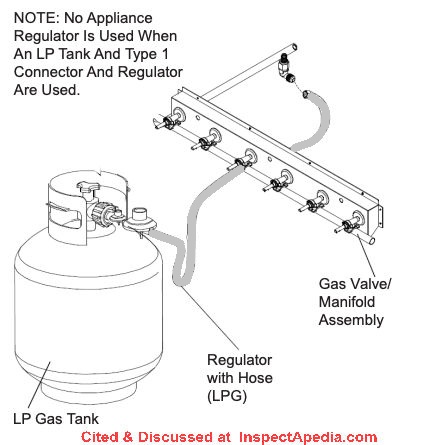
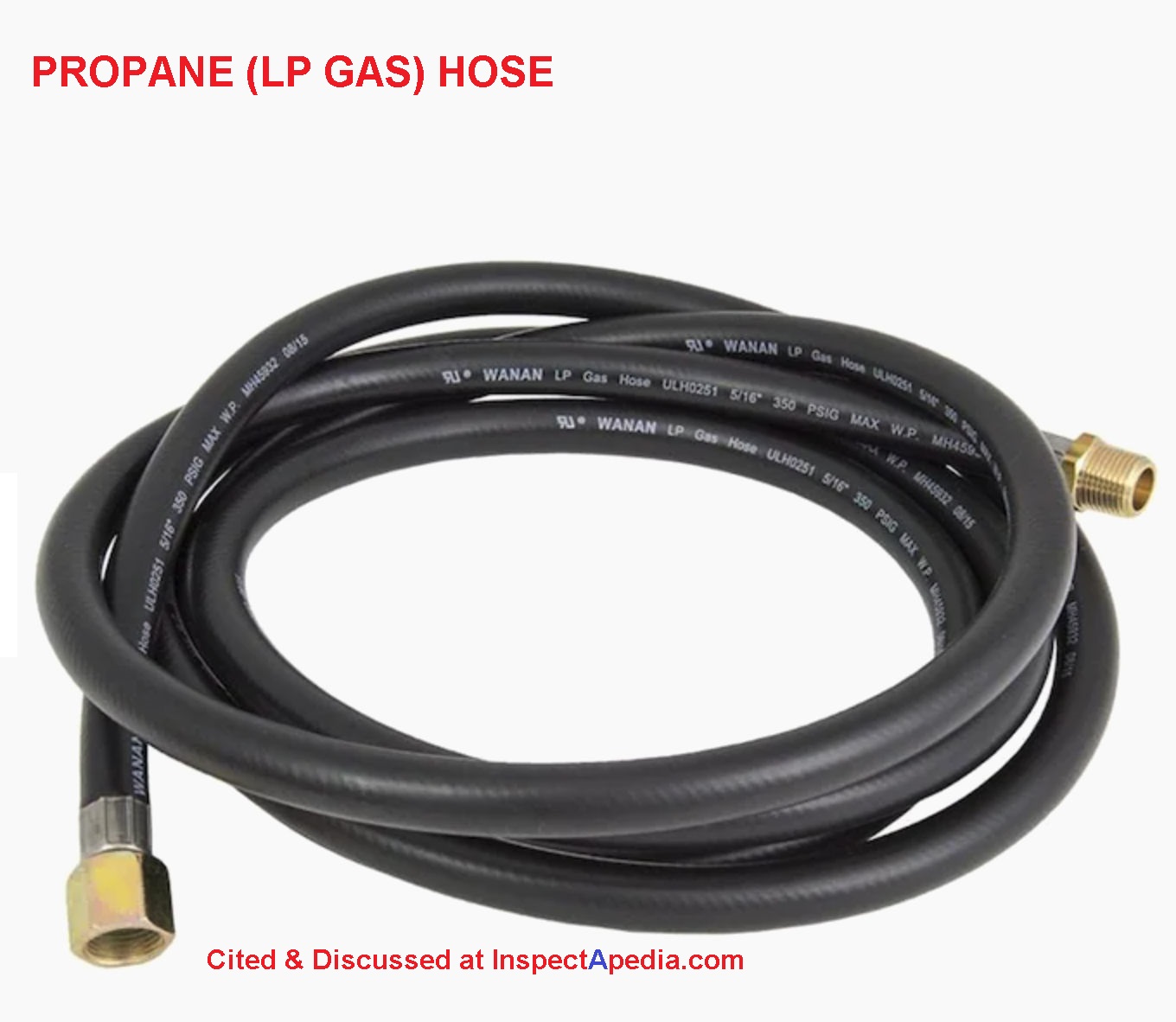
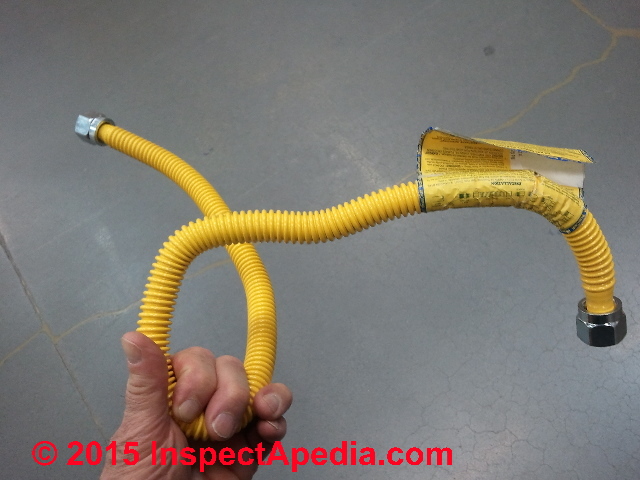
No one has commented yet. Be the first!